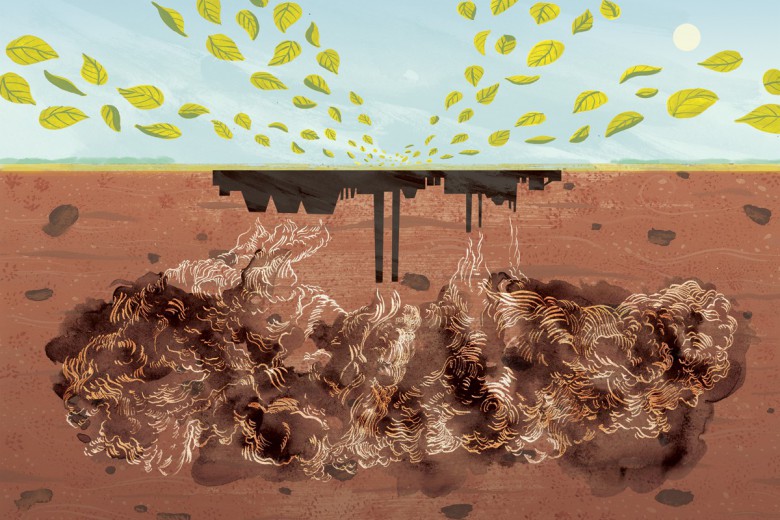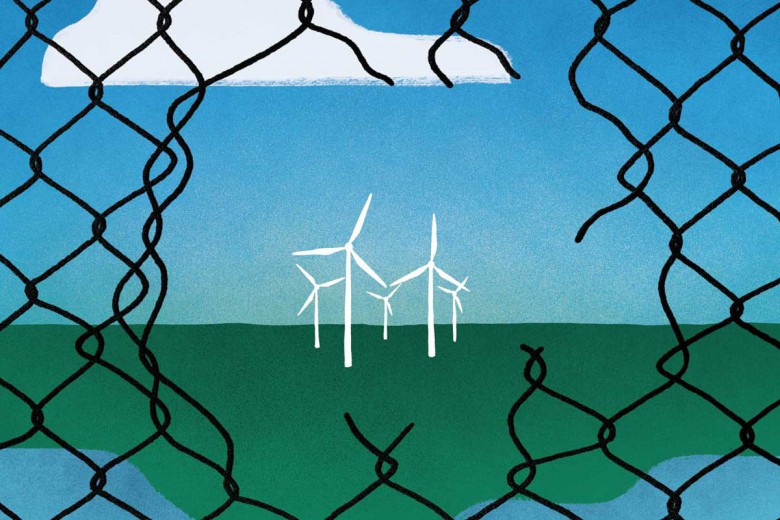On the morning of November 7, Maclean’s tweeted out the cover of its latest issue: a remarkably smug photo of the five Canadian political leaders who form the so-called “resistance” to the federal carbon tax plan. The quintet of conservative white men (Saskatchewan’s Scott Moe, Alberta’s Jason Kenney, Manitoba’s Brian Pallister, Ontario’s Doug Ford, and the federal Conservatives’ Andrew Scheer) collectively represent “Justin Trudeau’s worst nightmare,” according to the cover’s text.
It was immediately slammed. Harsha Walia of No One Is Illegal described the cover as a “billboard of conservative white male mediocrity still killing the planet.” Twitter users mocked its premise by replacing the faces of the politicians with those of characters from King of the Hill and The Simpsons, while others added captions like “50 Shades of Beige” and “If Transformers were just minivans.” Entire news articles were dedicated to chronicling the fallout, including one by Global News that deemed it a political milestone for Premier Moe.
But after the dust settled, the premise seemed to remain intact: Canadian climate policy is now being fought almost exclusively over carbon pricing, and a politician’s support for the policy is a barometer of their “belief” in climate change. Four provinces – Saskatchewan, Manitoba, Ontario, and New Brunswick – have already refused or dropped out of the carbon pricing scheme. At this point, it seems the tax may end up being the main talking point of both the upcoming Alberta and federal elections.
And that’s a huge concern from a climate change perspective, especially an explicitly leftist one.
Canadian climate policy is now being fought almost exclusively over carbon pricing, and a politician’s support for the policy is a barometer of their “belief” in climate change.
Carbon pricing at current levels will not even bring us close to reducing our emissions enough to avoid catastrophic climate change. But even more than that, it’s also a deeply neoliberal and individualistic way of doing it – one that often excludes or minimizes impacts on fossil fuel corporations while downloading moral and financial responsibility on households who burn fossil fuels for transportation or heating. Perhaps most concerning of all is the way it serves to create resentment for – and siphon energy from – far more ambitious climate policy that would rapidly cut emissions, guarantee jobs, and improve public services for all.
“The Maclean’s cover highlights a continuing problem for everyone who studies climate policy,” says Russell Williams, associate professor of political science at Memorial University and expert on international climate governance, in an interview with Briarpatch. “We really are being forced into a two-sided dialogue where one side clearly doesn’t want to do anything about climate change and the other is offering us a complex array of policies that probably won’t be very effective in managing Canada’s emission problems, either. You’re forced to pick what’s behind door number two because door number one is so awful.”
“It really derails the more meaningful parts of the climate policy conversation”
Carbon pricing was never destined to become Canada’s main climate policy.
Back in 2003, shortly after the Liberal government ratified the Kyoto Protocol, the province of Ontario committed to phasing out its use of coal-fired power plants to generate electricity. They didn’t bother with “market-based solutions,” but just regulated coal out of existence. Electricity sector greenhouse gas emissions plummeted by an incredible 87 per cent between 2005 and 2015. It demonstrated that strong state intervention can make things happen, fast.
A similarly ambitious vision was articulated by the Trudeau government with the signing of the Pan-Canadian Framework on Clean Growth and Climate Change in December 2016 by every province and territory but Saskatchewan and Manitoba. But over the last two years, those regulatory tools have eroded or disappeared into the netherworld of stakeholder consultations.
Its zero-emissions vehicle mandate (which requires automobile manufacturers to produce a certain percentage of electric vehicles per year) is MIA. The Clean Fuel Standard (which would regulate the amount of carbon allowed in fuels) has been delayed until well after the next election.
Its critical methane regulations, which would see dangerous emissions from the oil and gas sector slashed by over 40 per cent by 2030, were pushed back by three years following industry pressure. The federal coal phaseout is rife with loopholes, with Nova Scotia allowed to combust the highly polluting fossil fuel until after 2030. Renewable energy has been largely left to the provinces, along with public transportation.
Carbon pricing was never destined to become Canada’s main climate policy.
That leaves carbon pricing. Crucially, the policy doesn’t actually regulate emissions; it only assigns a price to them based on a largely arbitrary calculation dubbed the “social cost of carbon,” which tends to ignore cumulative emissions, feedback loops, and the greatly disproportionate impacts of climate change on countries in the Global South. For many corporations, it becomes just another cost of doing business and doesn’t incent radical shifts. Many jurisdictions end up returning revenue from the carbon tax to industry via grants, subsidies, and tax breaks, further dulling the effect. The example of the B.C. carbon price, first introduced in 2008, is often pointed to by boosters to prove the effectiveness of the policy. But critics such as Marc Lee of the Canadian Centre for Policy Alternatives have observed that emissions were on a downward trajectory well before the carbon tax and the additional price paled in comparison to the existing gas tax, with two-thirds of the revenue supporting corporate income tax cuts.
In April, economist Mark Jaccard of Simon Fraser University calculated that a $50/tonne carbon price will achieve annual greenhouse gas emission reductions of between 10 and 15 megatonnes (MT) by 2030. To give that some context, the Ontario coal phaseout reduced emissions by over 28 MT. A report from early last year by all of Canada’s Auditors General concluded that annual reductions of 205 MT are required to hit the 2030 target. That means federally mandated carbon pricing may account for about seven per cent of what is required, at best. In fact, Jaccard had previously calculated that Canada’s carbon price would have to hit at least $250/tonne by 2030 to reach Trudeau’s target if carbon pricing was relied on as the primary policy.
Carbon pricing is “sort of a red herring,” says Jessica Green, associate professor of political science at the University of Toronto, in an interview with Briarpatch. “It really derails the more meaningful parts of the climate policy conversation that need to happen. There’s a squabble over something that is, environmentally speaking, less efficacious [than] other pieces of the puzzle.”
An obvious part of the puzzle for Green is phasing out fossil fuel subsidies, which are estimated at $3.3 billion per year in Canada: “The notion that we would be pricing carbon at the same time as we’re subsidizing the fossil fuel industry is preposterous, because you’re not going to get a clear market signal at all,” she says.
That means federally mandated carbon pricing may account for about seven per cent of what is required, at best.
Carbon pricing is also a scheme that’s plagued by exemptions. In Alberta, all fuel consumed by conventional oil and gas producers is exempt until 2023 under the carbon tax plan. Tarsands producers are paying a tiny average of 67 cents per barrel in carbon tax due to the complex sector-specific system that prices carbon pollution based on industry benchmarks rather than total emissions. That means large industrial facilities get a massive amount of “free” emissions before they must start paying for it, all in the name of protecting competitiveness. Tarsands producers can also deduct carbon tax from their royalty payments, effectively neutralizing the costs. In August, the federal government increased the threshold that industry can emit before having to pay the carbon tax, followed a few months later by major exemptions awarded for coal-fired power plants – by far the worst emitters in the country. In British Columbia, the NDP has frozen the carbon tax for the liquefied natural gas industry at $30/tonne, meaning that if the government increases the price on carbon in the future, it won’t apply to the soon-to-be highest single emitter in the province.
“It’s a fairly well-established fact at this point that the more complicated the policy instruments we choose, the less likely they are to be effective over the long term,” says Williams. “All these output-based pricing systems and sector-specific targets: economists may like all this and think it’s smart policy. But we know something about this on the politics side: when policy gets very complicated like that, you open up to a situation of regulatory capture.”
If ExxonMobil supports a climate policy, is it still a climate policy?
That isn’t an accident.
Many large oil and gas companies have come out in favour of carbon pricing in recent years. Alberta Premier Rachel Notley famously stood on stage with four tarsands CEOs while announcing the province’s Climate Leadership Plan in late 2015, signalling that strong climate policy can coexist with industry support. American oil supermajors including Shell and ExxonMobil have endorsed the concept as well.
Premier Notley rhetorically tied future increases of the Alberta carbon price and the ultimate success of the Pan-Canadian Framework to the construction of the Trans Mountain Expansion Project – her implied rationale being that carbon pricing will encourage per-barrel emissions to decrease over time and neutralize emissions growth. But in late August, Notley pulled Alberta out of the Pan-Canadian Framework and cancelled future carbon tax increases after a federal court revoked approvals for the Trans Mountain Expansion due to failures to properly consult with Indigenous peoples or assess marine impacts.
If tarsands production ends up expanding as predicted, its emissions will increase from 70 MT in 2015 to 115 MT in 2030, obliterating reductions made in other sectors and making it effectively impossible to meet the country’s Paris Agreement target without expensive emissions trading (which would see the government spending public money on environmental projects in other countries). A recent analysis by the Pembina Institute reported that Alberta’s energy regulator has granted approvals to tarsands projects that total 131 MT in emissions if they all proceed.
“If ExxonMobil is in favour of something, that means maybe there’s something wrong with this,” says Matthew Huber, associate professor of geography at Syracuse University and author of 2013’s Lifeblood: Oil, Freedom, and the Forces of Capital, in an interview with Briarpatch. “I absolutely think this is a bait and switch and an attempt to make the industry sort of appear to be doing something about climate change without really doing anything. They see it as a very clever way to avoid actual regulations that would tell them to stop doing things, like stop extracting.”
“They see it as a very clever way to avoid actual regulations that would tell them to stop doing things, like stop extracting.”
Green agrees: “In some ways it’s greenwashing, because they can say ‘we’re part of the solution.’ And then in some ways it’s being able to help control the direction of the policy discussion.”
Voters can often sense the injustice embedded in such policy arrangements. While industry can get away with emitting millions of tonnes of pollution into the atmosphere for extremely low cost, regular households are required to pay more and more for bills or at the pumps. At last count, 44 per cent of working Canadians were living paycheque to paycheque, with 40 per cent feeling overwhelmed by debt. It’s no wonder that conservatives have chosen to frame the carbon pricing plan the way they have, with the Fraser Institute dubbing it “a tax grab cloaked in green” and Scheer accusing Trudeau of “failing to make life affordable for Canadians.” A May 2018 poll indicated that 72 per cent of Ontarians think carbon pricing is a tax grab, with 68 per cent criticizing it as only a symbolic gesture.
“When you call your climate solution a tax, it plays into that populist resistance,” Huber says. “It allows the right to argue that this policy is going to actually cost you, and cost your family, and cost your life.” He adds later that it “fails to clearly explain to the vast majority of working people how it will improve their lives.”
To be sure, rebates may help in some instances, with low-income households predicted to actually make money from the plan due to rebates. But there are multiple complicating factors: rebates are contingent on people filing their taxes, which households don’t always do for a range of reasons including complex paperwork, newcomer status, or worries about triggering audits of previous years. Low-wage workers need more money in their pockets today to pay for expenses, not every quarter or once a year, as carbon pricing rebates tend to be dispersed. Such households also have far less ability to retrofit their homes to cut down on energy costs, especially if they’re renting, or to upgrade their car with a more efficient model.
“When you call your climate solution a tax, it plays into that populist resistance.”
Huber said that while giving most of the carbon tax back in the form of rebates can be politically popular, it “very wrongly privatizes the revenue and benefits” by “just assuming again that this problem can be solved purely through markets and the price mechanism that the carbon fee is supposed to unleash.” It’s a fundamentally libertarian approach.
Economists Fergus Green and Richard Denniss recently argued in a journal article for Climatic Change that carbon pricing is often shunned in public opinion – but that other policies, such as “restrictive supply-side policy instruments” that limit fossil fuel production, can excite voters, improve international co-operation, and create political feedback loops that support other climate policies down the road. The authors described this process as “sequencing policies.” The idea is that you start with climate policy that people like rather than something they’ll instinctively turn against. Carbon pricing could play a small role – but it should be implemented way down the line, to accentuate other regulations that radically slash emissions.
This holds massive potential for progressive climate activists wishing to articulate a vision that moves beyond carbon pricing to something far more meaningful and liberatory.
Make the rich pay
We know that states have enormous power to implement climate policies that would radically reduce emissions, create jobs, and improve public services. And none of them include putting a price on carbon as a primary measure.
Here are just a few of the options: phase out oil, gas, and coal extraction; stop subsidizing fossil fuels; build low-carbon energy; initiate massive public works projects like a green housing program, construct energy-efficient social housing for low-income residents, and retrofit existing buildings with electric heat pumps, efficient appliances, and added insulation; fund public transportation, including urban, rural, and intercity options; construct a network of nationwide electrified passenger and freight trains; employ people to clean up abandoned wells, tailings lakes, and mining waste to prepare the land for return to Indigenous peoples; work with farmers to reduce agricultural emissions.
Such policies would cost a significant amount of money. Huber pointed to recent policy offerings in the United States as prime examples of how leftists could frame these moves, including Cynthia Nixon’s “polluter’s fee” that specifically targeted fossil fuel companies and Bernie Sanders’ “Wall Street Tax,” which advocated for financial speculation to be taxed to directly fund free college and pay down student debt for everyone. In both instances, the burden was placed on extremely wealthy individuals and corporations to pay the costs of big spending, not struggling households which resent the idea of increased taxes, however small.
In both instances, the burden was placed on extremely wealthy individuals and corporations to pay the costs of big spending, not struggling households which resent the idea of increased taxes, however small.
The two richest Canadian families own the same amount of wealth as the poorest 30 per cent of the country. Some $300 billion of Canadian wealth is being stored in offshore tax havens. Under pressure from the U.S., Canada is increasing its military spending to almost $25 billion per year. There’s plenty of money being hoarded and wasted on brutal imperialist projects that can pay for this transition.
Conservatives opposing carbon pricing are almost certainly doing so due to climate denialism, influence by the fossil fuel industry, or both. That doesn’t mean some of their basic critiques of carbon pricing are incorrect. The policy is indeed next to useless on the emissions reductions front, allowing huge industrial polluters to pay very little compared to costs imposed on regular households. It’s a fundamentally gradualist policy that assumes a certain amount of climate change is acceptable under a perverse “social cost of carbon” calculation, while ignoring the fact that poor Global South countries and low-income communities of colour in the Global North will be hardest hit by the consequences. And it tends to just piss people off, not invigorate them about the possibility of a just and sustainable future.
The challenge for leftists going forward will be articulating a strong vision that acknowledges the terrifyingly real existence of climate change while prioritizing policies that genuinely seek economic redistribution, good jobs, and decolonization. That will first require us to reject the deification of carbon pricing. A far better world is possible – but we’ll have to mount our own progressive resistance to get there.




_780_520_90_s_c1_c_c.jpg)


